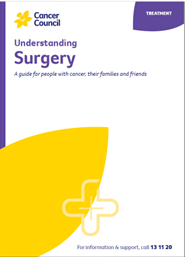- Home
- Primary bone cancer
- Treatment
- Surgery
Surgery for primary bone cancer
The type of operation you have will depend on where the cancer is in the body.
Learn more about:
- Limb sparing surgery
- Surgery to remove the limb (amputation)
- Surgery for bone cancer in other parts of the body
Limb-sparing surgery
Surgery to remove the cancer but save (salvage) the arm or leg (limb) can be done in most people. You will have a general anaesthetic, and the surgeon will remove the affected part of the bone. The surgeon will also take out some surrounding normal-looking bone and muscle with a layer of surrounding normal tissue. This is called a wide local excision, and it reduces the chance of the cancer coming back. A pathologist checks the tissue to see whether the edges are clear of cancer cells.
The bone that is removed is usually replaced with a metal implant or a bone graft. A graft uses healthy bone from another part of your body or from a “bone bank”. A bone bank is a facility that collects tissue for research and surgery. In some cases, the removed bone is treated with radiation therapy to destroy the cancer cells, then used to reconstruct the limb.
After surgery, you will be given medicine to manage pain and reduce the chance of getting an infection in the bone or metal implant. There are likely to be some changes in the way the limb looks, feels or works.
A physiotherapist can show you exercises to help you regain strength and improve how the limb works.
Surgery to remove the limb (amputation)
In cases when it is not possible to remove the cancer without affecting the arm or leg too much, the limb is removed (amputation). For about 1 in 10 people, this is the only way to remove the cancer completely. This procedure is less common now because techniques used for limb-sparing surgery have improved.
After surgery, you will be given medicine to manage the pain and taught how to care for the stump that remains (residual limb). After the area has healed, you may be fitted for an artificial limb (prosthesis).
If you have an arm removed, an occupational therapist will teach you how to eat and dress yourself using one arm. If you receive a prosthetic arm, the occupational therapist will teach you exercises and techniques to control and use the prosthesis.
If you have a leg removed and receive a prosthesis, a physiotherapist will show you exercises and techniques to improve how you walk and move with your new limb. Some people choose to use a wheelchair instead of a prosthetic leg.
Surgery in other parts of the body
| Pelvis | When possible, the cancer is removed along with some healthy tissue around it (wide local excision). Some people may need to have a bone graft or a metal implant to rebuild the bone. |
| Jaw or cheek bone (mandible or maxilla) | The surgeon will remove the affected bone. Bones from other parts of the body may be used to replace the affected bone. As the face is a delicate area, it may be difficult to remove the cancer with surgery and some people may need to have other chemotherapy or radiation therapy. |
| Spine or skull | If surgery isn’t possible, a combination of radiation therapy and chemotherapy may be used. If you need one of these treatments, your doctor will explain what will happen. |
To learn more, see our general section on Surgery.
Podcast: Making Treatment Decisions
Listen to more episodes from our podcast for people affected by cancer
More resources
Prof Peter Choong AO, Orthopaedic Surgeon, and Sir Hugh Devine Professor, St Vincent’s Hospital, and Head of Department of Surgery, The University of Melbourne, VIC; Catherine Chapman, Adolescent and Young Adult and Sarcoma Cancer Specialist Nurse, Division of Cancer and Ambulatory Support, Canberra Hospital, ACT; A/Prof Paul Craft AM, Medical Oncologist, Canberra Hospital and Australian National University, ACT; Belinda Fowlie, Bone Tumour Nurse Practitioner Candidate, SA Bone and Soft Tissue Tumour Unit, Flinders Medical Centre, SA; Prof Angela Hong, Radiation Oncologist, Chris O’Brien Lifehouse, and Clinical Professor, The University of Sydney, NSW; Vicki Moss, Nurse Practitioner, SA Bone and Soft Tissue Tumour Unit, Flinders Medical Centre, SA; A/Prof and Dr Marianne Phillips, Paediatric and Adolescent Oncologist and Palliative Care Physician, Perth Children’s Hospital, WA; Chris Sibthorpe, 13 11 20 Consultant, Cancer Council Queensland; Stephanie Webster, Consumer.
View the Cancer Council NSW editorial policy.
View all publications or call 13 11 20 for free printed copies.

